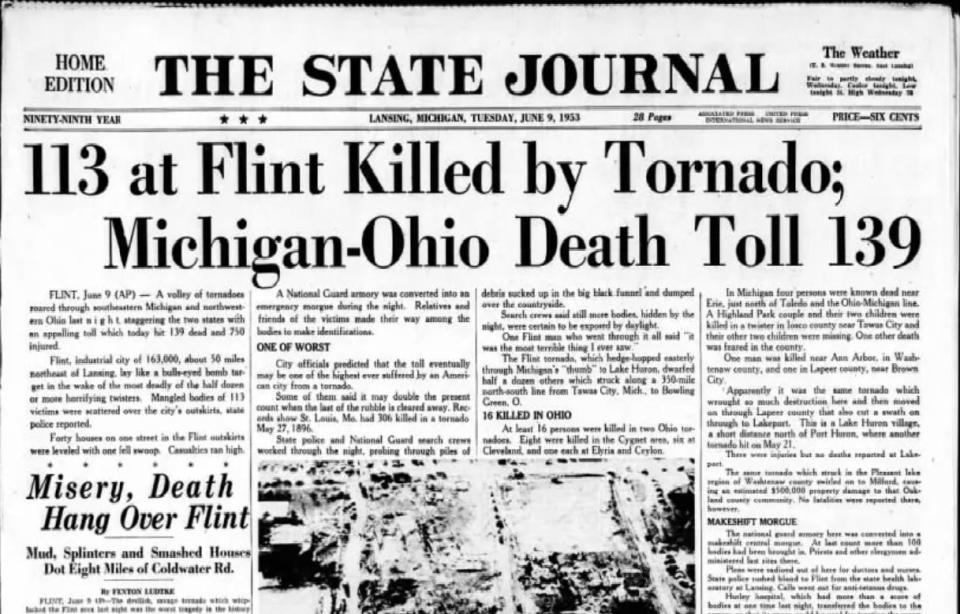Michigan's worst-ever tornado was like an atomic bomb, leveling a big swath of Flint
Weather watchers are warning that a "powerful low-pressure system" is headed Wednesday toward Michigan, bringing with it the potential for thunderstorms, ping-pong ball-sized hail and deadly tornadoes — violent, funnel-shaped columns — as warm and cold air collide.
A tornado watch, in effect in Michigan until 4 p.m., is something to take seriously, especially after so much storm destruction in the past few days. Between 6 p.m. to 9 p.m., forecasters add, there's another good chance for high winds, hail and twisters.
"Whenever we talk about tornadoes, it's nothing to fool around with," National Weather Service meteorologist Alex Manion said early Wednesday, emphasizing the dangers twisters pose. Not only are tornadoes violent, but on average, you often only get 10 to 15 minutes to seek shelter from one. "They are always a threat."

If a twister does touch down, forecasters add, they pray it is nothing like the rare one that hit Flint in the summer of 1953, the worst on record in Michigan and one of the worst in the nation. It hit on June 8, resulting in 116 deaths and 844 injuries, according to the weather service.
That tornado — rated as an F5, the most intense — stood as the worst ever with more than 100 fatalities, until 2011, when a catastrophic, mile-wide tornado leveled about a third of Joplin, Missouri, and killed at least 161 people, destroying about 4,500 homes and businesses, and caused an estimated $3 billion in damage.
And what made it even worse, is it followed another deadly tornado that touched down in May.
15 tornadoes a year
Last Friday, tornadoes tore across Midwestern and Southern states, killing at least 32 people and injuring more and leaving communities in shambles and without power as governors declared a state of emergency, sought federal aid, and called out the National Guard.
More: Severe weather Wednesday could bring tornadoes, hail, damaging winds to metro Detroit
More: Final Michigan State shooting victim released from Sparrow Hospital
If that weren't bad enough, the National Weather Service said, more tornadoes were reported on Monday evening — again — throughout the Midwest, including Iowa, Illinois and Missouri, and with the potential for more in Arkansas and Texas.
Michigan averages about 15 tornadoes a year, according to the state's emergency preparedness program. But it's still especially difficult to predict exactly where a tornado, which can spin at more than 200 mph, will hit. That's why disaster preparedness experts say it's essential to heed alerts.
The Flint tornado was so devastating that the Lansing State Journal ran a two-line head across its front page, with a report that noted "mangled bodies of 113 victims were scattered over the city's outskirts" and the "National Guard armory was converted into an emergency morgue during the night."
Like an atomic bomb
The day after the Flint tornado touched down, Free Press writer Jerome Hansen compared the storm's aftermath in a personal essay to the destruction he also witnessed from the atomic bomb detonation in Nagasaki, Japan. He said the devastation was "like a scene from Dante's 'Inferno.' "
He wrote that he was one of the first American troops to see the atomic bomb devastation. And what he witnessed in Flint, he said, was "strikingly similar," with everything in the twister's path "completely leveled" with "nothing standing as far as the eye could see."
"Houses flattened. Trees uprooted," Hansen observed. "Cars looking as if a gigantic hand had pressed them down. Drainage ditches on both sides of the road, six feet deep and filled with debris. Lumber, bricks, and glass that a few hours ago were brand-new homes."
"Maybe you won't believe this," he added as if he almost didn't. "But I saw a car three feet high. That's right, three feet high. Simply squished into the group by the unbelievable force of the tornado. Further down the road was another car. A huge tree sprouted through the steel top."
Better weather prediction
Another report, a few days later on the front page of the Port Huron Times Herald, noted that a piece of paper — the birth certificate of an 8-year-old girl who was killed in the tornado — was blown 60 miles away to Lake Shore by the awesome force of the storm's winds.
President Dwight Eisenhower flew over Flint, the Free Press reported, to inspect the damage.
And more than the physical destruction, the Free Press reported, thousands of Michiganders mourned the loss of loved ones at funerals and burials. Two-thousand people attended one outdoor Mass alone the Saturday after the tornado struck. Those in attendance included people in bandages and casts, hurt in the storm.
Over the years, forecasters and disaster management officials developed better weather prediction and early warning systems.
A tornado watch means atmospheric conditions are ripe for a twister and you should be close enough to a shelter or sturdy building if one is approaching. Stay alert, keep an eye on the sky, and stay tuned to the radio or television for information.
A tornado warning means a twister has been sighted or indicated by weather radar and you should take shelter.
Contact Frank Witsil: 313-222-5022 or fwitsil@freepress.com.
This article originally appeared on Detroit Free Press: Michigan's worst tornado hit Flint in 1953

